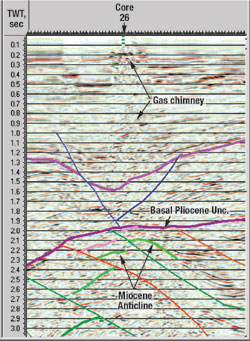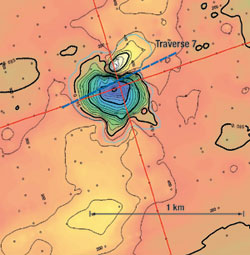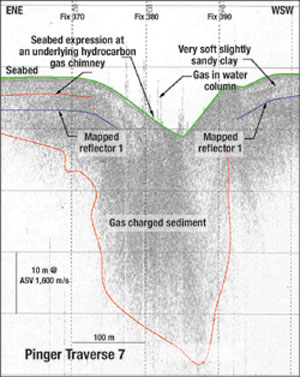How a venting feature offshore Equatorial Guinea led to a discovery
Exploration TechnologyHow a venting feature offshore Equatorial Guinea led to a discoveryA direct hydrocarbon-migration indicator showed itself on various data types. Rarely does it look this goodJoseph A. Canales, CMS Oil and Gas Co. Hydrocarbon venting and seepage features are associated with producing fields in Equatorial Guinea, including Zafiro and Alba fields. The 2000 discovery drilled by CMS Oil and Gas and partners in Equatorial Guinea, the Estrella-1, offsets a gas chimney and seafloor-venting feature. The seafloor expression of this vent feature is a crater 400 m wide and 17 m deep. A mound 6.5 m high is present on the northeast side of the crater, and a broader low-relief mound of ejected material 1.5 m high extends over 1.5 km to the southwest and beyond the survey area. Pinger records show hydrocarbons within the water column rising from several streams within the crater. Introduction It has been stated that, in general, hydrocarbon seepage can only effect the risk of encountering hydrocarbons on a basin-wide scale.1 However, the active tectonism and high sedimentation rates present offshore Equatorial Guinea in the Rio Del Rey basin have resulted in seeps vertically near hydrocarbon accumulations at depth. At CMS Oil and Gas, evidence of hydrocarbon venting or seepage over a deeper structural trap in Equatorial Guinea is considered a risk-reducing attribute for exploration plays. A 3-D survey showed a gas chimney associated with a structural culmination at depth of the Middle Miocene Isongo formation. The culmination is associated with a toe-thrusted anticline. Offset well ties indicated the presence of good reservoir rock within the targeted interval, and nearby production at Alba field indicated hydrocarbon generation in the basin. A piston-core surface-geochemical program that concluded in February 2000 by TDI-Brooks Int'l confirmed active hydrocarbon migration to the seafloor. Two of three cores targeting the seismic gas chimney recovered high levels of extractable hydrocarbons from piston-cored samples. Details of the venting crater were illustrated by data gathered from a site survey over the Estrella Isongo culmination. Method And Theory Identification of venting hydrocarbons over the Middle Miocene Isongo formation structure was confirmed using various data with a wide range of resolution.2 A suspected gas chimney was first identified on an exploration 3-D survey, Fig. 1. This data was acquired in 1995 by PGS using five 3,000-m cables. Sixty-fold coverage was recovered over the bulk of the survey, except for an area around an installed platform at Alba field. Shorter 1,500-m cables were used to get nearer the platform, resulting in a drop of coverage to 30 fold.
The data was reprocessed in 1999 by JDK, employing a pre-stack time-migration algorithm. An incremental improvement was achieved that has aided in interpreting the highly deformed toe-thrust belt, where the Estrella seep has been identified. Structural interpretation of the 3-D volume indicates that the gas chimney is located in a Pliocene syncline over a toe-thrusted, Middle Miocene anticline. The "hole" on the "hill" apparently results from reactivation of the thrust faults with a normal fault, back-slide movement. This counter-regional movement may be attributed to changing loads as the Pliocene section progrades from behind the toe-thrust belt, to loading over the thrust anticlines. As the overlying section slides back, a zone of dilation occurs in the middle of the syncline, which allows vertical migration up the shale-prone Lower to Middle Pliocene section. Horizontal migration is evident in the shallower sand-prone section, although much of the hydrocarbons continue vertically up to the seafloor, as is confirmed by piston coring. On the basis of the 3-D survey, an area-wide surface geochemical exploration program was outlined, including the acquisition of 36 piston cores. Three of these cores were acquired over the Estrella gas chimney. Two of the three cores (Cores 26 and 28) recovered high amounts of extractable hydrocarbon and headspace gas, which qualify them as containing migrated thermogenic oil and gas.3 Geomark provided further geochemical work incorporated with the TDI-Brooks study. Their findings showed Core 26, which fell within the crater, with low levels of biodegradation, suggesting an active hydrocarbon seep from below. Armed with the optimism of live oil at the seafloor, two exploration locations were finalized and a site survey was acquired over the area. The survey used an echo sounder, sidescan sonar, hull mounted pinger, coring and high-resolution seismic data. The bathymetry map, Fig. 2, shows a crater, as described above, associated with the venting of material, including hydrocarbons. The piston core with the highest readings of extractable hydrocarbons, Core 26, fell in the middle of the crater. The two other gas-chimney-targeted cores fell on the flanks of the crater. One had only background levels of extractable organic matter (EOM), while the other contained elevated levels of EOM.
The pinger data showed a broad area of gas-charged sediments below the crater and hydrocarbons in the water column above the crater rising in several streams, Fig. 3.
The high-resolution seismic data showed a history of gaseous eruptions recorded in a section about 300 ms of below the seafloor. Data further below is masked by poor returns of the seismic signal. Conclusions The geology associated with this venting feature suggests vertical hydrocarbon migration. The Estrella culmination focuses hydrocarbons within the Isongo sands. These, in turn, are feeding the gas chimney, which is illuminated by the seismic data. Live oil at the seafloor documented by piston cores highlights the active nature of the seep. The mud prone crater / mound feature suggests a prolific and rapid venting. The success of Estrella-1, which encountered about 200-ft gross of hydrocarbon bearing sand, confirmed this direct hydrocarbon indicator. Literature Cited 1 Thrasher, J., A. J. Fleet, S. J. Hay, M. Hovland and S. Düppenbecker, "Understanding geology as the key to using seepage in exploration: Spectrum of seepage styles," in D. Schumacher and M. A. Abrams, eds., "Hydrocarbon migration and its near-surface expression: AAPG Memoir 66," pp. 223 – 241, 1996. 2 Roberts, Harry H., "Evidence of episodic delivery of fluids and gases to the seafloor and impacts of delivery rate on surficial geology," AAPG Bulletin, Vol. 82, Iss. 13, 1998. 3 Proprietary TDI-Brooks Technical Report. Acknowledgment The author thanks CMS Oil and Gas Co.; Globex Energy, Inc.; Samedan Oil Corp.; the Ministry of Mines and Energy, Republic of Equatorial Guinea; and Marathon Oil Corp., current operator of the field, for permission to publish this article. Thanks also to John Van Horn, Jeff Bryant and Che Rivers for help and encouragement, and Bob Olson for suggesting this topic. This article derives from a poster presented at the SEG Int’l Exposition and Seventy-First Annual Mtg., San Antonio, Texas, Sept. 9 – 14, 2001.
|
||||||||||||||||
- Quantum computing and subsurface prediction (January 2024)
- Machine learning-assisted induced seismicity characterization of the Ellenburger formation, Midland basin (August 2023)
- What's new in exploration (March 2023)
- Seismic and its contribution to the energy transition (January 2023)
- International Forecast: Some noticeable recovery is finally underway (September 2022)
- What's New in Exploration: Rocks can save or kill the planet (July 2022)
- Applying ultra-deep LWD resistivity technology successfully in a SAGD operation (May 2019)
- Adoption of wireless intelligent completions advances (May 2019)
- Majors double down as takeaway crunch eases (April 2019)
- What’s new in well logging and formation evaluation (April 2019)
- Qualification of a 20,000-psi subsea BOP: A collaborative approach (February 2019)
- ConocoPhillips’ Greg Leveille sees rapid trajectory of technical advancement continuing (February 2019)






